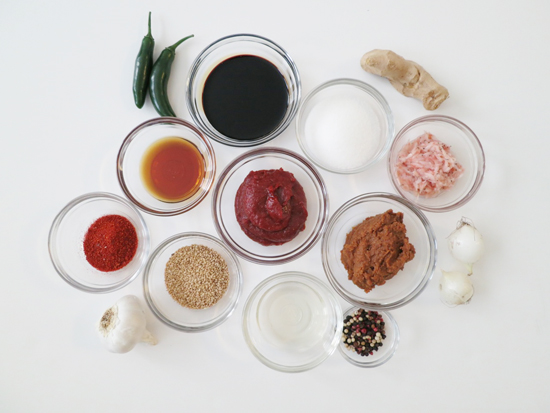Hopefully, you were able to join us at last week’s “How to Prepare a Korean Feast” event. As we said when we posted photos form the evening, we “got schooled” by our presenters on where to find the best Korean restaurants in New York, how to turn any CSA subscription into a multiple course Korean meal, and how to make one of the most iconic Korean dishes: kimchi.
If you’re like us though, you may not have been taking notes ($5 Brooklyn Brewery beers, ok?). Unfortunately, we don’t have have superhuman memories, so we followed up with Ann and Janet Chung of We Rub You to see if they would write up the list of basic Korean pantry ingredients that they shared with us last Wednesday. Basically, we needed a cheat sheet. Here’s what they gave us (each profiled in the slideshow above):
Ganjang: Also known as soy sauce; we usually buy by the gallon since we go through it pretty fast! This is the first of the “three jangs” of Korean cuisine. These jangs, especially ones that are produced with artisanal methods, can vary greatly depending on where they are produced. We’d say that the jangs are like the cheese of Korean cuisinein that they are deeply tied to the Korean identity and are a product of the terroir of the region in which they are produced.
Denjang: The second of the three jangs. This is similar to what most people recognize as miso, but we’d say it has a deeper, richer flavor. It’s great as a soup base.
Gochujang: This quintessentially Korean ingredient is the third and the youngest of the three jangs, since red chili peppers were introduced to Korea during the mid-1500s. This is the stuff that’s in bibimbap and you can put it on anything and it will taste good! It’s spicy, savory, and sometimes sweet — so pretty much addictive.
Toasted sesame seeds and toasted sesame seed oil: Don’t make the mistake of buying regular sesame seeds or sesame oil. It’s got to be toasted to achieve that nutty flavor.
Gochugaru (red pepper powder): Gochugaru is used to make kimchi. You have to make sure you’ve got the right mesh, though. The coarser ground red pepper works for kimchi and the finer ground works for making homemade gochujang.
Saewoo Jut: This ingredient is minuscule wild caught shrimp fermented in a salt water brine. You can use it like you would a fish sauce. We put it in our steamed eggs, use it to make dipping sauces, etc. You can even add it to your kimchi, if you want to lend it a flavor of the sea.
Rice wine vinegar: If you don’t have rice wine vinegar, then feel free to substitute apple cider vinegar. This is one area where we feel like you can deviate and use whatever vinegar you have on hand.
Some more common ingredients that are also key to any Korean pantry can include sugar, ground black pepper, garlic, onion, and ginger.



